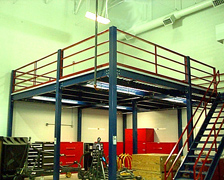The selective pallet rack/racking is the most common pallet racking system in use today. It’s typically come in one of two configurations: a roll formed, or clip-in configuration, and a structural bolt-together configuration. Roll formed selective rack is most commonly manufactured in a "teardrop" style. The nickname “teardrop” comes from the fact that the holes on the column of the upright are shaped like a teardrop. Pallets then rest on the horizontal load beams that are held in place by mounting clips. Because the clips on teardrop configurations can be quickly moved, the shelves can be easily adjusted to different heights to accommodate various load sizes. This is convenient for a warehouse that needs to store a wide variety of product sizes.
Structural pallet rack systems are very similar to roll formed pallet rack systems except the horizontal load beams are attached to the uprights with bolts and have much greater weight-bearing capacity. Also, structural pallet racking can be designed into the structure of the building itself, so that the upright columns are simultaneously used to support the roof of the storage facility, in which case the structural pallet rack uprights replace the storage building’s vertical support I-beams.
One of the most popular forms is the mezzanine rack system. In this kind of pallet rack, it is often used in shops and similar spaces for storage of tools or materials. The high roof of the shop is ideal for a mezzanine, and offices can be put either below or above it. Mezzanines are frequently used in industrial operations such as warehousing, distribution or manufacturing. These facilities have high ceilings, allowing unused space to be utilized within the vertical cube. Industrial mezzanine structures are typically either structural, roll formed, rack-supported, or shelf-supported, allowing high density storage within the mezzanine structure.

No comments:
Post a Comment